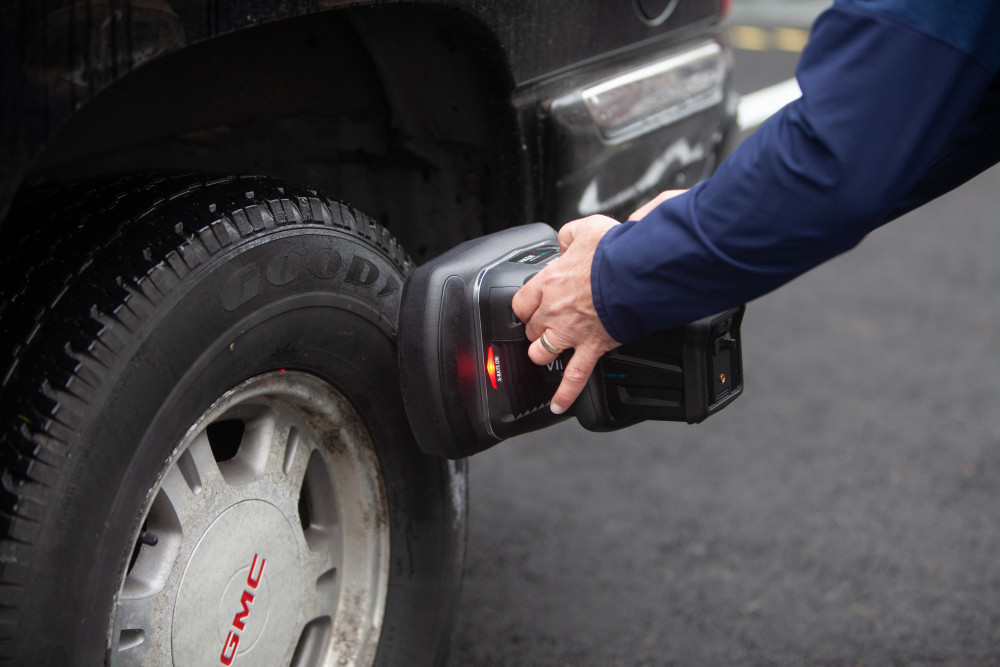
A new line of X-ray scanners being offered by Viken Detection, ranging from handheld devices to vehicle-focused drive over scanners, offers law enforcement and others the possibility of greater flexibility and capability in contraband detection, including the possibility to see through lead.
Based on reflective X-ray technology, the devices offer the promise of a quick, safe means of ferreting out everything from explosives to narcotics, and a new method of fighting the opioid crisis. While the handheld version, the HBI-120, has been available for years, it’s the addition of Viken’s more stable, high-power version geared toward security checkpoints that adds layers of possibility.
Jim Ryan, Viken Detection’s CEO, described the company’s focus as one of public safety, and for the moment, drug interdiction.
“Backscatter in general is the basis of our system,” Ryan said, referring to an advanced X-ray imaging technology that works by detecting the radiation reflected from a target. “We understand transmission X-ray. We understand XRF, not just imaging, but identifying specific materials. We’re able to pull all those together with good imaging software.”
While X-ray scanners are aplenty in the modern world, what gives Viken a leg up on the competition is its ability to scan on just one side of a target to get its full picture, cutting wait times significantly, along with its ability to overcome lead. The handheld version is a simple, portable 8 pound device capable of peering into vehicles reaching inside steel panels to check for contraband in hidden compartments, without requiring passengers or drivers to leave the vehicle. The higher the energy directed to the device, the farther it can penetrate, making containers, crew quarters and others all fair game.
The handheld version is based on Android software, allowing for adaptability of applications for different customers. It’s also capable of detection in mere seconds. In a demonstration to Homeland Preparedness News, Ryan and his team showed its efficacy both inches away and from several feet back. Hidden contraband lit up in both displays on a range of items – wheels, car hoods and even a bumper lined with lead to disguise from X-rays – with only the level of detail affected.
With the presence of a lead-lined wall, the device clearly detected the irregularity, giving investigators a warning that would enable them to take a closer look and remove the obstruction. Without XRF technology, investigators are hamstrung in terms of what they can see because lead makes the imaging bounce back clean.
Viken, based in Burlington, Mass., took what it learned from development of these handheld devices to make its Osprey Under Vehicle X-ray (UVX) system, as well. That’s the stable, checkpoint-based version of the technology designed for vehicles’ undercarriages, identified by former and current drug interdiction officers as the hardest area to inspect. When a vehicle drives over the system at a few miles per hour, it provides images in real time, lighting up unusual items in ways that agents can then mark as suspicious or non-suspicious. It penetrates steel in a way that makes it nearly translucent, and Ryan is hopeful that with time and machine learning, the system will be able to help operators identify troubles.
If the system picks something up, analysts could then go in with the handheld X-ray for a closer look. It’s currently targeted for border applications, but Ryan also sees prospects for military bases, embassies and other high-traffic areas.
“It’s all about layers,” Ryan said. “The more layers you put in, the better chance you have. Those layers have to be ubiquitous. You want everyone to go through the same thing with multiple layers. That’s when you have the best chance of catching, in large quantities, these drugs or other hazards coming into the country.”
While these systems are primarily utilized by U.S. Customs and Border Protection (CBP) at the southern border of the United States, Viken launched a program in June that offered its handheld devices to police departments in communities struggling with opioid epidemics. Departments in Oklahoma, Tennessee, Mississippi, Georgia and Indiana all benefited initially as part of the Viken Assisting Law-enforcement in the Opioid Response (VALOR) program.
VALOR unites refurbished or demo units to such departments either freely or at cost, with an eye on fighting opioids. A 50-employee company, Viken also provides training to recipients. For Ryan and the company, it’s a matter of improving safety and effectiveness for officers at a time when synthetic drugs are getting more concentrated and dangerous.
“We’d like them to be able to stand off and see these things without touching it, knowing it’s there and using proper means to extract it,” Ryan said.




